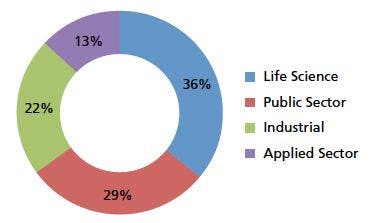Keith Bartle: Creative Catalyst
LCGC North America
Keith Bartle talks about his proudest scientific achievements.
Keith Bartle, Emeritus Professor of Physical Chemistry and Visiting Professor in the Energy Centre of the University of Leeds, UK, has been a creative catalyst in a wide range of chromatographic collaborations stretching from the analysis of methane in air to printing inks. He spoke to Caroline West from the University of Orléans, in Orléans, France, about his career in chromatography and his proudest scientific achievements in separation science, including his research in supercritical fluid chromatography (SFC), gas chromatography (GC), and “the unified chromatograph.”
Caroline West: When did you first become interested in chemistry and what was the appeal?
Keith Bartle:
At school I was actually directed toward the classics: a narrow escape! I was fascinated by the idea of chemical change. How did the coal in the firebox of the Thames–Clyde Express railway engine passing and shaking my home become converted to energy? How was Bakelite, an early polymer, made? How was oil of wintergreen, a remedy for backache, extracted from a plant? It was all so preferable to conjugating Latin verbs and quoting Roman emperors. Rudimentary apparatuses and a surprising range of chemicals could be bought by post at that time-so there were a number of narrow escapes there too!
CW: Did you have a mentor who inspired you and guided you toward separation science?
KB: My Ph.D. work was in nuclear magnetic resonance (NMR) spectroscopy, but inspired by Denis Desty (BP) and Marcel Golay (PerkinElmer, Norwalk, Connecticut), I had long been interested in the high resolution offered by capillary gas chromatography (GC). This led to an association dating from 1968 with Milos Novotny (Indiana University, Bloomington, Indiana) and later with Milton Lee (Brigham Young University, Provo, Utah). Peter Myers (University of Liverpool, Liverpool, UK) has always been a strong and supportive influence. But the decision to work with supercritical fluids was because of my Head of Department, Peter Gray, who perceptively encouraged Tony Clifford (both University of Leeds, Leeds, UK) to use his formidable knowledge of physical chemistry to supply the theoretical back-up for the work that encompassed supercritical fluid chromatography (SFC), extraction, and reactions in supercritical fluids. Tony and I cooperated for many years and because of him our work was always rooted in sound science (1–3).
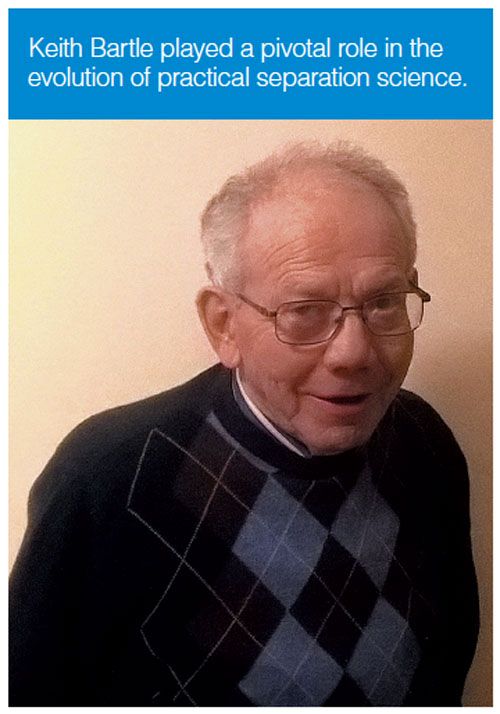
Keith Bartle played a pivotal role in the evolution of practical separation science.
CLICK IMAGE TO ENLARGE
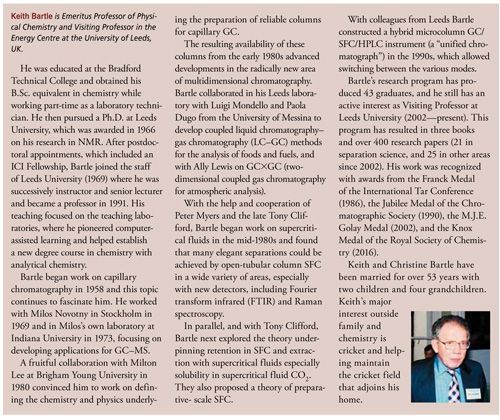
CW: When you started working in chromatography, I suspect that you built your own systems because no commercial systems would have been available. When did you see chromatography transforming from an art into science?
KB: Back in the early days of chromatography there was great confusion over column technology. High-performance column packings for liquid chromatography (LC) were only just coming on stream-but were quickly adopted-and people like Peter Myers, who were active in this area, actually revolutionized separation science by making available high-resolution high performance (HP)LC columns that provided repeatable and reproducible separations. The manufacture of reliable (then glass) capillary columns for GC proved more difficult, spawning a vast, sometimes contradictory literature: Too often based on anecdote, rather than any firm grasp of the underlying science. The advent of fused silica and the subsequent defining of the chemistry and physics of coating fused-silica columns changed all that.
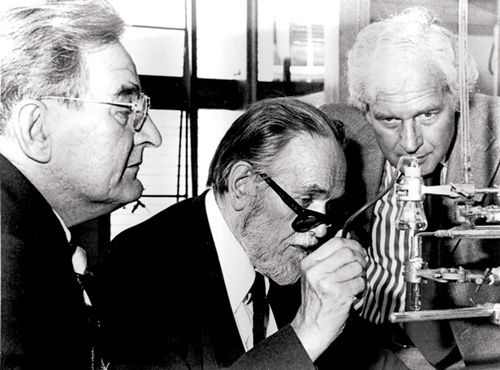
One of Keith’s major influences, Denis Desty, with (left to right) Archer Martin and Victor Pretorius. Published with permission from Peter Myers.
CW: For my part, I have always found that a bit of ignorance was useful when going in a new direction, because it helps accepting new observations without preconceptions. It must have been an exciting era to start supercritical fluid chromatography when nothing had been done before. How did you progress in this direction?
KB: Yes, in fact SFC was suggested (4) as early as 1957 by James Lovelock and was demonstrated by Ernst Klesper in 1962 (5) as a way of making use of the favorable properties of supercritical fluids as mobile phases, such as high densities (leading to greater solvent power), low viscosities (allowing low pressure drops), and faster diffusion (producing greater chromatographic efficiency), but our first SFC separations used conventional HPLC columns. We were completely in the dark, not knowing what would happen. Would the home-built chromatograph separate a test mixture? Would it explode? We remembered that supercritical fluids were compressible! We retired behind safety shields and waited, and were rewarded by a respectable chromatogram, which made us keen to persist. But it could have all gone pear-shaped and I would have had to return to the NMR lab!
CW: As a university professor, you must have been widely solicited with many teaching and administrative duties, in addition to research. Did you find it hard to find the balance between research and university duties?
KB: I found there are two cardinal rules here. First, always do your teaching to the absolute best of your ability. I have done my share-much of it in the teaching laboratories I was responsible for-and look back on this with great affection. Second, try to minimize the time you spend in meetings. Ask yourself whether you need to be there and also whether what is being talked about is outside the “circle of control.” It is unlikely that the government will respond to complaints voiced at chemistry department staff meetings, however well justified! Additionally, I always tried to multitask, occasionally with unforeseen results. For example, I sometimes overdid my time-saving modus operandi of holding “walk and talk” discussions while moving down the corridor and this led my students to provide me with a Doppler effect T-shirt: on the front, the slogan “Blue Shift:Approaching,” and on the back “Red Shift:Receding.” I took the hint. Networking is vital though: I know sabbaticals are difficult these days, but do try to travel. I heard John Phillips (Southern Illinois University, Carbondale, Illinois) introduce two-dimensional GC (GC×GC) at a meeting in the United States. The subsequent development and application of this method by Ally Lewis in the atmospheric chemistry programs first at Leeds and then at the University of York proved groundbreaking and absolutely invaluable.
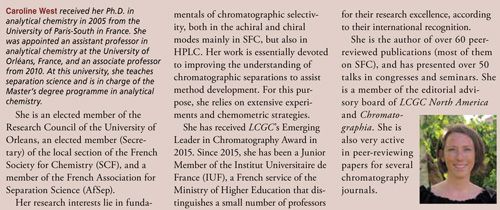
CW: In the current state of chemistry, analytical chemistry, and chromatography in particular, is often considered as the poor relative by other branches of chemistry. Perhaps this is because education in separation science is faulty in many universities around the world. As a professor and researcher, how did you try to transfer your knowledge and passion for separation science?
KB: Yes, the “other chemists” can be very irritating! My response is to tell them to try doing whatever they do without separation science, then drink up and leave, consoling myself with recent remarks by medicinal chemist Derek Lowe (6): “Chromatography hasn’t just made organic chemistry easier, in most cases it makes it possible.” In really annoying situations you can, as an example of chromatographic science, ask critics for their views on Professor John Knox’s papers on band broadening (7). As for my efforts, I hope I did my bit for chromatography by helping to initiate the Leeds chemistry with analytical chemistry degree course, which was heavily biased toward separations, and by teaching several component modules. And many of my graduate students have gone on to senior posts in the UK and elsewhere. But I have to say that chromatographers are not always entirely their own best friends, as shown by the unseemly quarrel, thankfully now all in the past, between exponents of packed and capillary columns for SFC.
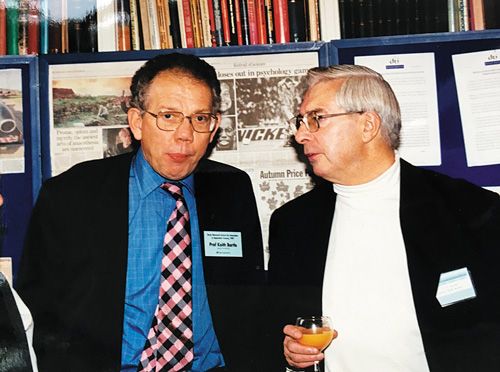
Keith Bartle with Ted Adlard, an early pioneer of gas chromatography.
CW: Can you describe your relation to students in the laboratory? Did your students’ interests influence your projects?
KB: Well, they were all different, but I tried to make sure they were clear about the goals of what they were doing. I never believed in micromanagement but positively encouraged independence and indeed serendipity. One example is Daixin Tong’s independent work on packing microcolumns (8,9), which underpinned our later work in unified chromatography (10–12) and also our capillary electrochromatography program (13,14). Students always knew that if they had results to show I would do my best to get them to (usually) highly enjoyable conferences.
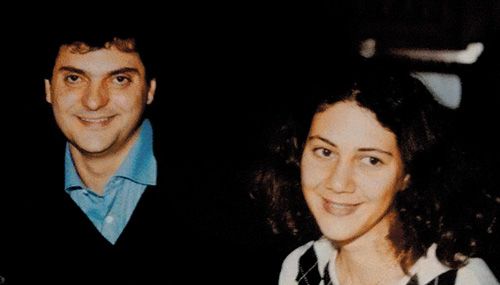
Lugi Mondello and Paola Dugo collaborated with Bartle to develop practical applications for on-line LC-GC systems for food and essential oil analysis.
CW: In the current state of academic research, state funds are scarce and most scientists must rely on industry contracts. Did you have connections with industries to develop your research?
KB: One way or another most of our work was funded by industry. You see, I was always encouraged by the retort of the Roman Emperor Vespasian: “Pecunia non olet” (“money has no odor”). Also, by Louis Pasteur’s definition: “There are no such things as applied sciences, only applications of science.” Examples from the many diverse applications of science by our group would include the extraction and analysis of anticancer drug precursors from yew needles (15); the determination of additives and oligomers in PET polymers by supercritical fluid chromatography-Fourier transform infrared spectroscopy (SFC–FT-IR) (16); and the establishment of the role of unburned fuel in emissions from diesel engines.
CW: In the 1980s, SFC found a variety of applications: pharmaceuticals (17), natural products (18), polymers, and additives (19). Then, it was partly abandoned by a vast majority of academics and users to remain essentially present as a preparative technique for enantioresolution in the pharmaceutical industry. Today, the application fields open up again as interest is aroused by the introduction of modern, robust analytical systems. What other fields would you find interesting to investigate with SFC now?
KB: Of course, we need much more practical activity in the pharmaceutical industry. To do this we need to improve all of the resolution, selectivity, and sensitivity issues. It seems that mass spectrometry (MS) is developing at breakneck speed and its impact on separation science-always significant-will grow even more in the near future as techniques such as Fourier transform ion cyclotron resonance mass spectrometry (FT-ICR-MS) and two dimensional mass spectrometry (2D MS) develop. In fact, I have even heard it suggested that MS may even replace chromatography! But, like Mark Twain, “I suspect that rumors of its demise are probably exaggerated!” At the end of my lecture courses I always advised students that, whatever else they did, they should listen to the MS people. Meanwhile, I would like to work to maximize the opportunities offered by SFC–MS, and also pursue the advantages of the new robust unified instrumentation. When we began work in SFC we found that with the equipment available at the time, pressure regulation, control of mobile-phase composition, and reliability were insufficient for routine use. In 1981, however, Milos and Milton realized that SFC could be performed on capillary columns in conventional chromatographs in what was an extension of GC. The modern unified instruments with packed microcolumns take account of the advantages of all chromatographic modes and have small flow rates (and are hence “green”) and peak volumes.
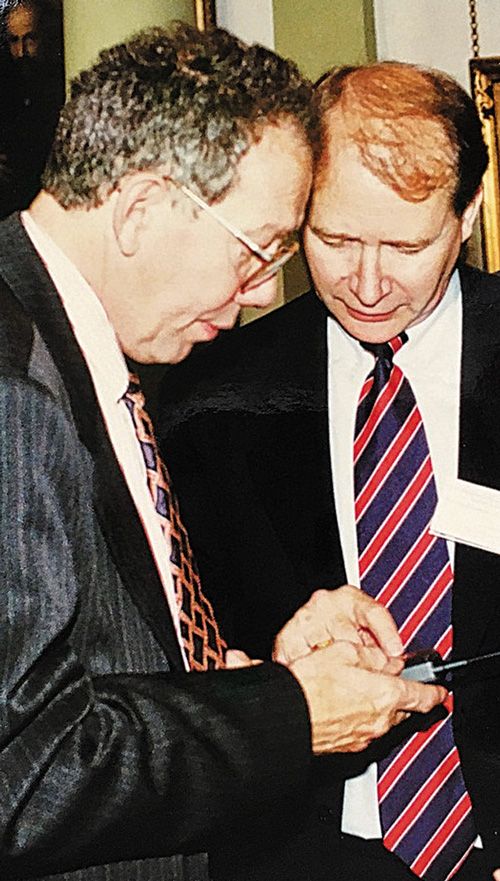
Keith Bartle and his mentor Peter Myers. at an early Desty Symposium.
CW: If you were a beginner in separation science today, what field would you find most inspiring? What would you most like to investigate?
KB: There are many fields I find inspiring. I would like to explore the expansion of “open-access” SFC. Increasingly, a specialist analyst is not required. I would also look at improved SFC separations for chiral compounds. Richard Ansell (University of Leeds) has found molecular imprinted polymer stationary phases very promising in this area (20) and size-exclusion chromatography (SEC) should also be investigated further. SEC has lagged and we need to improve it by making use of the new stationary and mobile phases. We also need an improved understanding of SFC retention near the critical point and the effect of additives. The new generation of instruments (and chromatographers!) make this an exciting time for chromatography research. Multidimensional chromatography will be driven by analytical necessity, but 2D LC×LC is very promising; outstanding results have been obtained here by Paola Dugo of the University of Messina, in Italy (21).
CW: If you could change something in your scientific path, what would it be?
KB: I should have listened to my mentors: to Milos Novotny and learned some biology, and to Peter Myers and learned some more surface chemistry!
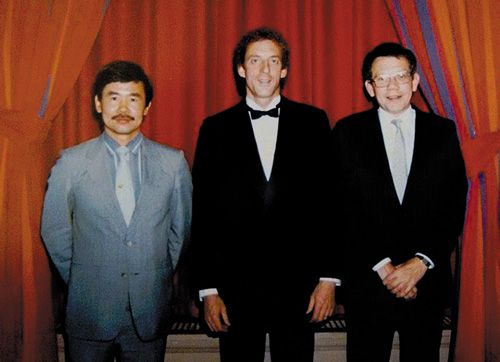
From left to right: Frank Yang, Milton Lee, and Keith Bartle at the launch of their book on capilllary GC in 1984.
CW: What would you qualify as your most significant contribution to separation science? What research are you most proud of?
KB: Three specific collaborations, perhaps, gave me most pleasure, much of it because of the people involved. I worked with Milton Lee on research to understand the coating of fused-silica capillary GC columns (22). I worked with Luigi Mondello and Paola Dugo (from the University of Messina, Messina, Italy) on a project to develop methods using coupled LC–GC. In on-line LC–GC, high-resolution LC fractions are transferred to a capillary GC column for further separation; it has become the method of choice, for example, in essential oils, and in detecting adulteration of olive oils. Luigi Mondello has published an excellent review on this topic (23).
I have also worked with Bob Robinson, Tony Edge, Mark Raynor, and Daixin Tong (all University of Leeds) in constructing “the unified chromatograph” (10–12). The versatility of this instrument was made clear in the operation of the system in so-called “enhanced fluidity” or variable temperature mode with a (programmable) mixture of eluent starting with carbon dioxide as the initial mobile phase-and hence operating in SFC mode-then programming all the way to the polar liquid phase-that is, to HPLC. There were two important findings here: The importance of solubility in determining retention, and the enormous selectivity resulting from the variation of pressure, temperature, and mobile- phase composition.
And I always had the benefit of Tony Clifford’s firm grasp of physical chemistry, and the enthusiasm of Peter Myers: “C’mon Keith, we can do that,” he would say!
CW: Do you have any advice for any younger separation scientists embarking on a career in separation science?
KB: First, and most important, always remember Derek Lowe’s comment that I mentioned previously. What you do is important! While making full use of established techniques be aware of developments in new areas-such as coupling to MS, comprehensive multidimensional methods-and be prepared for the possibility that a less familiar approach may be just the solution for a specific problem. For example, GC with atomic emission detection for the analysis of toxic emissions from landfill sites (24); Peter Myers’s electric field gradient focusing for protein separation (25); Ally Lewis’s GC on a chip (26); and Tony Clifford’s determination of solubilities in superheated water chromatographically (27).
References
- K. Barker, K.D. Bartle, and A.A. Clifford, Chem. Eng. Commun. 68, 177–184 (1988).
- K.D. Bartle, A.A. Cliford, D. Mills, and R. Moulder, J. Chem. Soc. Faraday Trans I 25(8), 2347–2353 (1989).
- K.D. Bartle, A.A. Clifford, S.A. Jafar, and G.F. Shilstone, J. Phys. Chem. Ref. Data20(4), 713–730 (1991).
- J.E. Lovelock, paper presented at the 132nd American Chemical Society Meeting Symposium on Advances n Gas Chromatography, 1957.
- E. Klesper, A.H. Corwin, and D.A. Turner, J. Org. Chem.27, 700–706 (1962).
- D. Lowe, Chemistry World24(12), 24 (2014).
- J.H. Knox, J. Chromatogr. 831(1), 3–15 (1999)
- D. Tong, K.D. Bartle, A.A. Clifford, and A.M. Edge, J. Microcol. Sep.6(3) 249–255 (1994).
- D. Tong, K.D. Bartle, A.A. Clifford, and A.M. Edge, J. Microcol. Sep.7(3), 265–278 (1995).
- D. Tong, K.D. Bartle, and A.A. Clifford, J. Chromatogr. A.703, 17–35 (1995).
- D. Tong, K.D. Bartle, A.A. Clifford, and R.E. Robinson, The Analyst120, 2461–2470 (1995).
- K.D. Bartle, in Unified Chromatography, J.F. Parcher and T.L. Chester, Eds. (ACS Symposium Series. 748, 2000), pp. 142–167.
- M.G. Cikallo, K.D. Bartle, M.M. Robson, P. Myers, and M.R. Euerby, The Analyst 123, 87R–102R (1998).
- K.D. Bartle and P. Myers, J. Chromatogr. A16, 3–23 (2001).
- D.M. Heaton, K.D. Bartle, C.M. Rayner, and A.A. Clifford, J. High Res. Chromatogr. 16, 666–670 (1993).
- M.W. Raynor, A.A. Clifford, K.D. Bartle, C. Rayner, A. Williams, and B.W. Cook, J. Microcol. Sepn. 1, 101–109 (1989).
- K.D. Bartle, C.D. Bevan, A.A. Clifford, S.A. Jafar, N. Malak, and M.S. Verrall, J. Chromatogr. A 697, 579–585 (1995).
- K.D. Bartle and A.A. Clifford, in Advances in Applied Lipid Research, F.B. Padley, Ed. (Jai Press, London, UK, vol. 1, 1992), pp. 217–264.
- K.D. Bartle, T. Boddington, A.A. Clifford, N.J. Cotton, and C.J. Dowle, Anal. Chem.63, 2371–2377 (1991)
- R.J. Ansell, K.L. Kush, D. Wang, C.E. Sanders, K.D. Bartle, and A.A. Clifford, J. Chromatogr. A1264, 117–123 (2012).
- P. Dugo, F. Cacciola, T. Kumm, G. Dugo, and L. Mondello, J. Chromatogr. A.1184(1), 353–368 (2008).
- K.D. Bartle, C.L. Woolley, K.E. Markides, M.L. Lee, and R.S. Hansen, J. Sep. Sci.10(3), 128–136 (1987).
- L. Mondello, G. Dugo, and K.D. Bartle, J. Microcol. Sep.8(4), 275–310 (1996).
- A.B. Ross, K.D. Bartle, S. Junyapoon, and J.M. Jones, J. Int. J. Environ. Anal.Chem.82, 47–55 (2002).
- P. Myers and K.D. Bartle, J. Chromatogr. A.1044, 253–258 (2010).
- A. Lewis, J.F. Hamilton, C. Rhodes, J. Halliday, K.D. Bartle, et al., J. Chromatogr. A1217, 768–774 (2010).
- N. Jones, A.A. Clifford, K.D. Bartle, and P. Myers, J. Sep. Science33, 3107–3109 (2010).
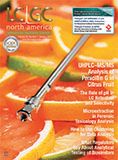
Thermodynamic Insights into Organic Solvent Extraction for Chemical Analysis of Medical Devices
April 16th 2025A new study, published by a researcher from Chemical Characterization Solutions in Minnesota, explored a new approach for sample preparation for the chemical characterization of medical devices.
Sorbonne Researchers Develop Miniaturized GC Detector for VOC Analysis
April 16th 2025A team of scientists from the Paris university developed and optimized MAVERIC, a miniaturized and autonomous gas chromatography (GC) system coupled to a nano-gravimetric detector (NGD) based on a NEMS (nano-electromechanical-system) resonator.
Miniaturized GC–MS Method for BVOC Analysis of Spanish Trees
April 16th 2025University of Valladolid scientists used a miniaturized method for analyzing biogenic volatile organic compounds (BVOCs) emitted by tree species, using headspace solid-phase microextraction coupled with gas chromatography and quadrupole time-of-flight mass spectrometry (HS-SPME-GC–QTOF-MS) has been developed.
A Guide to (U)HPLC Column Selection for Protein Analysis
April 16th 2025Analytical scientists are faced with the task of finding the right column from an almost unmanageable range of products. This paper focuses on columns that enable protein analysis under native conditions through size exclusion, hydrophobic interaction, and ion exchange chromatography. It will highlight the different column characteristics—pore size, particle size, base matrices, column dimensions, ligands—and which questions will help decide which columns to use.

